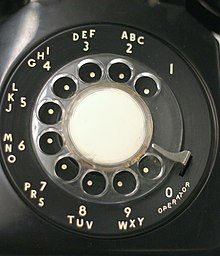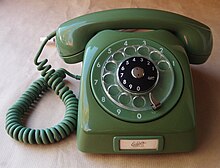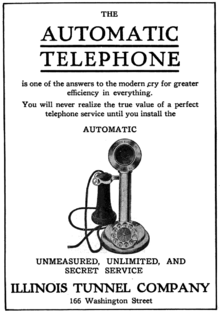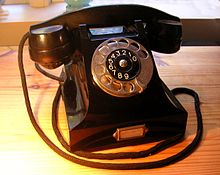Dial disk
A rotary dial is a component of a telephone or telephone switchboard that implements a telecommunications signaling technology known as pulse dialing. It is used when initiating a telephone call to transmit the destination telephone number to a telephone exchange.
On the telephone's rotary dial, the digits are arranged in a circular pattern so that a finger wheel can be rotated against spring tension with one finger. Starting from the position of each digit and rotating to the fixed finger stop position, the angle through which the dial is rotated corresponds to the desired digit. Compact telephones with the dial on the handset had all holes equally spaced on the dial and a spring-loaded finger stop with limited travel.
When released at the top of the finger, the wheel returns to its initial position spring-loaded at a speed regulated by a centrifugal governor device. During this return rotation, the dial interrupts the direct electrical current from the telephone line (local loop) the specified number of times associated with each digit and therefore generates electrical pulses that are decoded by the telephone exchange at each dialed digit. Each of the ten digits is encoded in sequences to correspond to the number of pulses, so the method is sometimes called decadic dialing.
The dial pulse contacts are normally closed, in series with the rest of the circuit components. The pulses briefly open the contacts for approximately 50 milliseconds. The headset is disconnected by the dial mechanism when dialing to prevent a very loud click from being heard in the headset. Slow release relays in the central office prevent the phone from being disconnected by dial pulses.
The first patent for a rotating dial was granted to Almon Brown Strowger (November 29, 1892) as US Patent 486,909, but the commonly known shape with finger wheel holes was not introduced until about 1904.[citation needed] While independent telephone company systems were used on the telephone, rotary dialing service on the Bell System in the United States was not common until the introduction of the Western Electric model 50AL in 1919.
Starting in the 1970s, the rotary dial was gradually replaced by DTMF (two-tone multi-frequency) push-button dialing, first introduced to the public at the 1962 World's Fair under the trade name &# 34;Touch-Tone". Tone technology primarily used a keyboard in the form of a rectangular array of push buttons.
History
From 1836 onwards, various suggestions and inventions of dials for sending telegraph signals were reported. After the first commercial telephone exchange was installed in 1878, the need for a user-controlled, automated method of directing a telephone call became apparent. Addressing technical deficiencies, Almon Brown Strowger invented a telephone dial in 1891. Prior to 1891, numerous competing inventions and 26 patents for dials, push buttons, and similar mechanisms specified methods of signaling a destination telephone station that a subscriber wanted. call. Most of the inventions involve expensive and intricate mechanisms and require the user to perform complex manipulations.[citation needed]
The first commercial installation of a telephone dial accompanied the first commercial installation of a 99-line automatic telephone exchange in La Porte, Indiana, in 1892, which was based on Strowger's 1891 designs. The original dials required sequences complex operations. The Automatic Electric Company invented a workable, though error-prone, system using three buttons on the telephone. These buttons represent the individual hundreds, tens, and ones in a phone number. When calling subscriber number 163, for example, the user had to press the hundreds button once, followed by six presses of the tens button and three presses of the ones button. In 1896, this system was superseded. by an automatic machine to make contacts.or calling device. Development continued through the 1890s and early 1900s along with improvements in switching technology.
Almon Brown Strowger was the first to file a patent for a rotary dial on December 21, 1891, which was granted on November 29, 1892 as US Patent 486,909. Early rotary dials used lugs on a finger plate instead of holes, and the pulse train was generated without control of spring action or a governor on the forward motion of the wheel, which proved difficult to operate correctly.
On rotary dial phones, smaller numbers like 2 are dialed faster than longer numbers like 9 (because the dial rotates a lot more with a 9). In 1947, area codes were introduced in the United States to facilitate direct dialing from a distance first by operators and then by subscribers. In the original system in use until 1995, the first digit of the area code could not be a one or a zero, but the second number had to be a one or a zero. This allowed the mechanical switching equipment at the central offices to distinguish local calls from " long distance ", since the one and the zero do not have associated letters that can spell the names of the telephone exchanges.
Therefore, the lowest and fastest code was 212; the highest and the slowest 909. The Bell System, in developing the original area codes, assigned the lower codes to the areas where they would be most used: the large cities. 212, the lowest number, was New York City. The next lowest, 213 and 312, were Los Angeles and Chicago. 214 was Dallas, 313 Detroit, and 412 was Pittsburgh. A high number, like 919, was assigned to North Carolina. An even higher number, 907 (higher because the 0 counts as 10), was Alaska.
In the 1950s, plastic materials were introduced into dial construction, replacing metal, which was heavier and subject to more wear.
Despite their lack of modern features, rotary phones occasionally find special uses. For example, the anti-drug coalition Fairlawn Coalition in the Anacostia section of Washington, D.C., persuaded the phone company to reinstate rotary-dial pay phones in the 1980s to discourage loitering by drug buyers, since the dials did not they could be used to leave coded digital messages on dealer pagers. names and pulse dialing.
Construction
A rotating dial is usually circular in construction. The shaft that drives the mechanical switching mechanism is driven by the finger wheel, a disk that has ten finger holes aligned close to the circumference. The finger wheel can be transparent or opaque, allowing the face plate or number plate below to be seen, either in its entirety or showing just the number assignment for each finger hole. The front plate is printed with numbers, and sometimes letters, corresponding to each finger hole. The 1 is normally set approximately 60 degrees clockwise from the highest point on the dial, or approximately at the 2 o'clock position, and then the numbers advance counterclockwise, with the 0 approximately at 5 o'clock.[citation needed] A curved device called a finger stop sits above the dial at approximately the 4 o'clock position. The physical nature of the dialing mechanism on rotary phones allowed the use of physical locking mechanisms to prevent unauthorized use. The lock could be integral to the phone or a separate device inserted through the finger hole closest to the finger stop to prevent the dial from turning.
Letters
In addition to numbers, the faceplate is often printed with letters that correspond to each finger hole. In North America, traditional dials have letter codes displayed with the numbers below the finger holes in the following pattern: 1, 2 ABC, 3 DEF, 4 GHI, 5 JKL, 6 MNO, 7 PRS, 8 TUV, 9 WXY and 0 (sometimes Z) Operator. The letters were associated with the dial numbers to represent the names of telephone exchanges in communities that had more than 9,999 telephone lines, and were additionally given a significant mnemonic to facilitate memorization of individual telephone numbers by incorporating their center names. For example: "RE7-xxxx" stood for "REgent 7-xxxx", where "Regent" a local exchange name used in Canada, derived from an earlier precursor phone number, '7xxxx', and callers actually dial '73 -7xxxx' (737-xxxx).
The use of letters on dials was proposed in 1917 by WG Blauvelt of AT&T. Large cities like New York would ultimately require a seven-digit number, but some testing in the early XX century indicated that many people's short-term memory could not handle seven digits and that many dialing errors could occur due to memory lapses (the documentation for these tests is lost).[citation needed ] Hence, the Panel's first automatic exchanges, opened in 1915 in Newark, New Jersey, used a "semi-automatic" in which the local operator keyed in the number for the person he was calling. And as large cities would have both manual and automatic switchboards for some years, the numbers of the manual or automated switchboards would have the same format (originally MULberry 3456, with three letters and later four numbers), which could be spoken or dialed.
In the UK, the letter "O" was combined with the digit "0" instead of "6". In large cities, seven-digit numbers consisted of three letters for the name of the exchange, followed by four numbers. Older Australian rotary dial phones had the corresponding letter of each number printed on a paper disk in the center of the plate, with a space where the subscriber could add the phone number.[citation needed ] The paper was protected by a clear plastic disk, held in place by a retaining ring shape that also served to locate the disk radially. The Australian letter to number mapping was A=1, B=2, F=3, J=4, L=5, M=6, U=7, W=8, X=9, Y=0, so the telephone number BX 3701 was in fact 29 3701. When Australia around 1960 switched to all-numeric telephone dialing, a mnemonic to help people associate letters with numbers was the phrase "All big fish jump like crazy under the water except the yabbies". However, these letter codes were not used in all countries.
Dials outside of Canada, the United States, and large cities in Great Britain (prior to all-digit dialing) generally did not have alphabetic characters or an indication of the word "operator" in addition to numbers.[citation needed] The alphabetic designation of interchanges with Cyrillic letters (А, Б, В, Г, Д, Е, Ж, И, К, Л for each of the digits 1 through 0 respectively) was also used for a brief period in the Soviet Union in the 1950s and 1960s, but in the following decade this practice was largely discontinued.
Function
To dial a number, the user places a finger in the corresponding hole and turns the dial clockwise until it stops. The user then removes their finger, and a spring on the dial returns it to the rest position. For example, if the user dials "6" in an American telephone, electrical contacts operated by a cam on the dial shaft and a ratchet will open and close six times when the dial returns to the home position, thus sending six pulses to the exchange.
Different impulse systems are used, which vary from country to country. For example, Sweden uses one pulse to signal the number zero and 10 pulses to signal the number nine. New Zealand uses ten pulses minus the desired number; so dialing 7 produces three pulses. In Norway, the American system with the number '1' was used; corresponding to a pulse, except in the capital, Oslo, which used the same "reverse" than in New Zealand.
For this reason, the numbers on the dial are changed in different countries, or even in different areas of a country, to work with their system due to the difference in the arrangement of the numbers on the dial. Dial numbering can occur in four different formats, with 0 adjacent to 1 or 9, and the numbers in ascending or descending order, with 0, 1, or 9 closest to the top of the finger.
Rotary dial phones do not have a redial feature; the full number must be dialed for each call attempt.
Since the late 1940s, telephones were redesigned with numbers and letters in a ring outside the thumbwheel for better visibility.
Emergency calls
A relic of these differences is found in the emergency phone numbers used in various countries; the UK selected 999 because of the ease of converting office call numbers to free calls. "0" for the operator it was already free, and the cam that eliminated the bypass in the line when the dial was turned to the "0" could be modified to include the adjacent digit "9" (and "8" if necessary) so that calls to "0" and "999" could be performed without inserting coins. In New Zealand, 111 was selected because New Zealand's reverse numbering dials make each digit "1" send 9 pulses to the central office / telephone exchange (as '9' in Great Britain), allowing British central office equipment to be used out of the box.
Recoil spring
Early dials worked by direct or indirect action. The pulses were generated as the dial was rotated towards the finger stop position. When the user's hand movement was erratic, it produced incorrect numbers. At the end of the 19th century, the dial was perfected to work automatically by means of a recoil spring. The user selected the digit to be dialed, turned the dial all the way, and then released it. The spring caused the dial to rotate back to its initial position during which a constant speed was maintained with a centrifugal governor.
Dials on user stations typically pulsed at a rate of ten pulses per second (pps), while dials on operator consoles at Crossbar or electronic exchanges often pulsed at 20 pps.
The rotary dial governor is subject to wear and aging and may require periodic cleaning, lubrication and adjustment by a telephone technician. In the video, the green led shows the impulse pulses of the dial and the red led shows the abnormal contact function of the dial.
Abnormal contacts usually have two additional functions. They can implement a shunt across the transmitter circuitry and induction coil to maximize the pulsing signal from the dial by removing all internal impedances from the telephone set. Another function is to short-circuit the telephone earpiece during dialing, to prevent the telephone user from hearing a clicking noise.
Dials within phones
Some phones include a small dial built into the earpiece, with a movable stop. The user turns the dial clockwise until the finger stop stops moving, then releases both. In this design, the holes extend around the entire circumference of the sphere, allowing for a reduced diameter. This was introduced by Western Electric in the compact Trimline telephone, the first to place the dial on the handset. In Spain, these phones were manufactured for CTNE (Compañía Telefónica Nacional de España) by "CITESA", a factory based in Malaga, being called "Góndola" because of its particular shape. Spanish Gondola sets were fitted early on with a series of red leds connected to the dial, allowing the dial ('disco' in Spanish) to be backlit while being dialed. For that, the led was bridged by an anti-parallel zener diode, to allow DC to pass through even if the line polarity were reversed. In case of line polarity inversion, the leds would not light up, but the phone would work anyway. The led and zener diode were contained in the same package to facilitate assembly in manufacturing.
Push Button Phones
In the UK, some early telephones (mid to late 1960s) were built which continued to provide the same rotary dial signaling on their PABX by using a separate converter to give 10-PPS, but they were operated with buttons. Some of these, such as the GPO 726 or 728, can be distinguished from touch-tone telephones by the lack of * and # keys and unusual key layout.
Later, the so-called "Autonomous" (SC) used a line-powered electronic circuit within the phone to convert the entered digits to give the 10-PPS that was required to function on normal public Strowger, Crossbar, or Electronic exchanges. They are GPO (BT) type 756 (without battery), 1/764 and 2/764 or 765 (with NiCD batteries), or 766 (without battery), to name a few. These also do not have the * or # keys.








